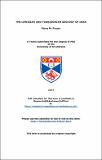The Lewisian and Torridonian geology of Iona
Abstract
The island of Iona is composed predominantly of Lewisian gneisses with Torridonian sediments outcropping on the east side.
The Lewisian gneisses include a wide range of lithological types. The prevalent quartzfeldspathic gneisses are biotite-hornblende-bearing, potash-rich and potash-poor varieties and hypersthene-biotite-garnet gneisses. Metasediments outcrop in two associations (i) within a sequence of basic and ultrabasic rocks (the ‘Amphibolite Group’) and (ii) in the NW of Iona (the NW Paragneisses). The Amphibolite Group contains concordant marble and iron-rich horizons which delineate the major fold structures in south and west Iona. Chemical analyses of the metasediments and basic rocks in the Amphibolite Group indicate that the sequence was probably originally a supracrustal group composed of tuffs, lavas, impure limestone and iron-rich chemical deposits. The NW paragneiss group may be a younger group of metasediments comprising graphite-quartz marbles, calc-silicate layers, graphitic schists, and garnet schists.
The tectonic history of the gneisses divides into six main deformations. The first (D₁) is represented by isoclinal intrafolial hinges with a penetrative S₁ foliation. The second deformation produced isoclinal folds with rounded hinges deforming the S₁ foliation. D₃ generated tight asymmetrical folds accompanied by a hornblende granulite facies metamorphism with syntectonic mineral growths defining S₃ and L₃, and axial planar pegmatite veins. The axial planes are generally at low angles to the foliation, which typically trends NE or E. D₄ folds are mostly large close folds with shallow short limbs and axial planes trending NE with NW dips, whilst D₆ formed open folds with N-trending axial planes, and accompanied by a high amphibolite facies metamorphism.
Basic dykes were intruded at various stages of the tectonic sequence: before D₁, between D₁ and D₂, D₂ and D₃, and D₅ and D₆. The dykes can be divided into distinct types on petrographical, chemical, and structural grounds. One set, the Banded Dykes, is composed of two intimately associated assemblages, hornblende-two-pyroxene-plagioclase and garnet-quartz-clinopyroxene-plagioclase. The latter is thought to have developed from the former during waning temperatures at constant pressure during D₃. The Banded Dykes also have distinct selvedges of an unusual mineral assemblage, garnet-orthopyroxene-plagioclase, probably due in part to chilling of the dyke on intrusion but mostly formed by metasomatic interchange with the enclosing gneisses during D₂ and D₃. Another dyke set, the Well-Lineated Dykes, also has these distinctive selvedges. These dykes also display a very well defined lineation formed by elongated clots of mafic minerals, and have a more basic chemistry than any of the other dyke sets. They appear to be comparable to the two-pyroxene norites of the Assynt district.
The Torridonian(?) sediments were deposited on the Lewisian after uplift and erosion. After consolidation they were probably metamorphosed at low greenschist facies. Activity on the Moine Thrust thrust the Moinian on to the Torridonian. Thrusting was accompanied by dynamic metamorphism, mylonitization of the Lewisian/Torridonian boundary, rotation of the Torridonian bedding planes to a steep SE dip and the formation of isoclinal folds, in association with a steep SE-dipping cleavage and an ESE elongation lineation. This deformation (D[subscript(t1)]) was followed by a generation of tight asymmetrical folds (D[subscript(t2)]) which deformed the mylonite foliation and was accompanied by a weak N-trending axial planar cleavage. D[subscript(t3)] produced kink bands and monoclonal folds with sub-horizontal fold axes, whilst D[subscript(t4)] caused conjugate or knee folds with NE- and SE-, and N- and E- trending axial planes. A pluton of adamellite, the Ross of Mull Granite, was intruded along the Moine Thrust plane after [subscript(t2)], and caused the thermal metamorphism of the Torridonian sediments, the mylonites and nearby Lewisian gneisses. The D[subscript(t1)] - D[subscript(t4)] events correlate closely with those occurring in the Moine Thrust zone between Durness and Skye.
Type
Thesis, PhD Doctor of Philosophy
Collections
Items in the St Andrews Research Repository are protected by copyright, with all rights reserved, unless otherwise indicated.

